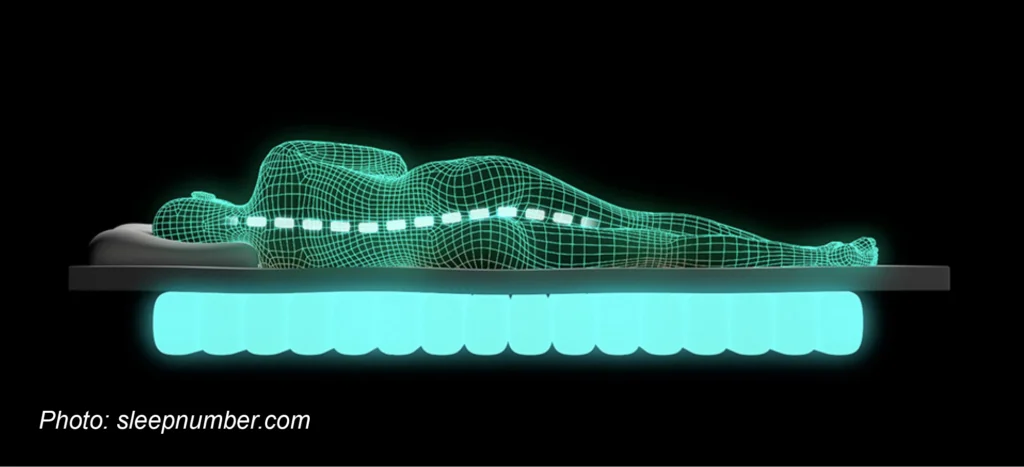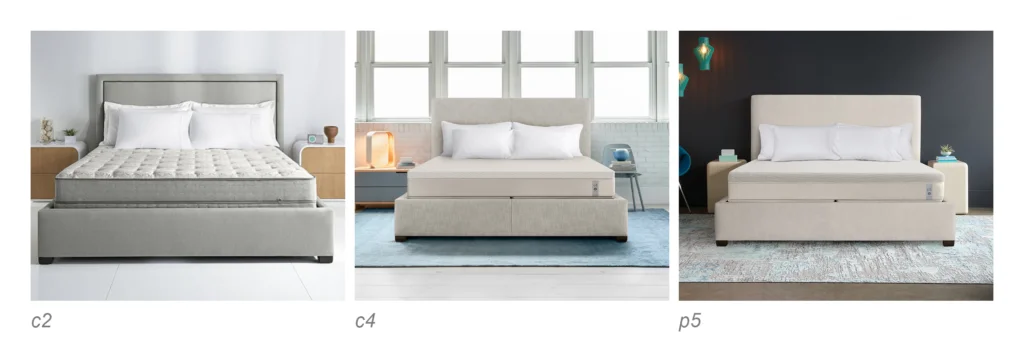A majority of the population sleeps on their side (74%, in fact!) so there’s a good chance if you’re reading this, you fall into the side-sleeper bucket.
When it comes to the best mattress for side sleepers, it’s important to choose wisely, since you’re probably susceptible to hip, back, or neck pain. While every body, is different, you should typically look for a mattress that provides medium to high firmness, good hip and neck support, and enough cushion to inhibit pelvic rotation.

If it’s hard to know exactly what type of support, firmness, and comfort you need, learning more about Sleep Number beds could be a smart option. These beds let you select a “Sleep Number” setting, which automatically makes your bed firmer or softer with the touch of a button. If you look into their 360 smart series beds, your mattress will have also have Responsive Air technology, which allows your bed to adjust to your movements while you sleep.
What Sleep Number Setting is Best for Me?
Sleep Number settings range from 0-100, and your number will be an increment of five. The higher the number, the more firm the bed will be. Most people have a Sleep Number between 30-60; any lower than 30 or higher than 60 will result in a bed that will (most likely) feel uncomfortably soft or hard.
Unfortunately, it’s impossible to spit out a single number that is best for all side sleepers. However, if you know you like hard beds, there’s a good chance your setting will fall in the 45-60 number range. If you know you like a little bit more softness, your number might be closer to 30.
It’s also important to look beyond the number and towards the Sleep Number comfort layer. Most beds (excluding the c2 model) will have an extra layer of foam above the air chambers to provide different levels of pressure relief and body contouring. The thickness of these foam layers ranges from two inches to seven. If you like squishy and soft beds that still provide solid and firm support, you could always try a combination of a higher sleep number setting with a thicker comfort layer. And if you know you like really hard beds, the c2 model might be the best bet, since there is no comfort foam layer and thus your bed will feel pretty firm, no matter your Sleep Number setting.
What Sleep Number Model Do You Recommend Then?
The higher the model number, the more inches of comfort foam will be on top of your mattress. Side sleepers typically prefer lower Sleep Number model numbers, so beds like the c2 and c4 and Sleep Number 360 p5 could be good choices. The other options — p5, p6, i7, i8, and i10 — will have significantly thicker layers of foam above the mattress (starting at five inches), which might not give enough support to people who sleep on their side.

How Do I Find My Setting?
Here is a step-by-step guide for finding your sleep number:
Lie down.
Get into bed (bring your Sleep Number remote or SleepIQ app!) and lie down on your side. Make sure your pillows are propped as they would if you were actually sleeping.
Find your setting.
If you have your remote:
- Press the Home button
- Select Sleep Number
- Use the up and down arrows to explore the different settings
If you’re in the SleepIQ® app:
- Open your Bed Controls
- Select the Sleep Number tab
- Tap Help Me Find My Sleep Number®
(Each model has a slightly different remote, so these steps might be a little different. However, both the remote and app are quite intuitive, so you shouldn’t have a problem navigating them.
Pay attention to how the bed feels.
Sleep Number recommends bringing your setting up to 100 to understand whatthat feels like. Then, as the number goes down you’ll feel the bed get more and softer. Pay attention to how your body feels and reacts as the air chamber deflates.
Choose a setting and stick with it for a few days.
The moment your body feels like it hit that sweet spot — as a side sleeper, this means the mattress should “fill in” to support the curves of your side — press Enter or Stop on your remote or app. The setting will automatically save so you don’t need to adjust anything. From there, try it out for a few days. If you’re finding that after a few days something still doesn’t feel totally right, you can try adjusting your number 5 or 10 notches.
While there’s no “right” number for a certain sleeping position, it’s helpful to know you can always adjust your Sleep Number setting to find something that works for your body. That, coupled with the different comfort layer options, means you should have good luck finding a firmness that best supports your side-sleeping needs.



























